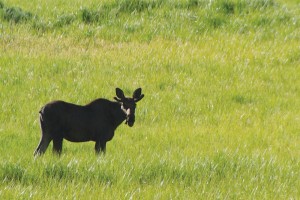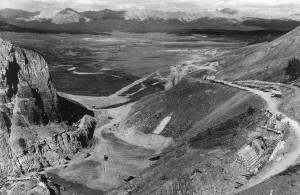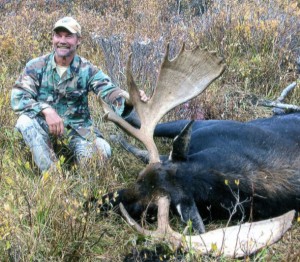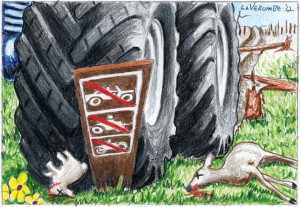By John Mattingly
The Western United States have always thought of themselves as different from the East, so it isn’t surprising that in matters of States’ Rights, the Western States burned their own brand of mischief, which, in one curious case became known as the Sagebrush Rebellion.
Sagebrush rebels practiced “uncooperative federalism,” or provocative non-compliance with a federal law when that federal law was at odds with a sensible state law, or when a federal law failed to measure up to Westerners’ standards of horse sense – or, in this case, donkey sense.
What many folks don’t know is the Sagebrush Rebellion was actually kicked off in the early 1970s by nineteen unbranded donkeys who were drinking from the Taylor Stock Well, a primary watering source on an 8,000 acre federal BLM (Bureau of Land Management) grazing lease in New Mexico.
The rancher who held the grazing permit serviced by the Taylor Stock Well was informed by the BLM that the donkeys were drinking from the well. Few things honk off a rancher more than the prospect of a bunch of worthless donkeys disturbing his cattle. The rancher could have run the donkeys off, or rounded them up and sold them. In the extreme, he could have called some buddies with guns. Instead, the rancher called the New Mexico Livestock Board, who, acting under authority of the New Mexico Estray Law, rounded up the nineteen unbranded donkeys and sold them at public auction.
Following this seemingly sensible, and ostensibly legal, action the BLM sued the New Mexico Livestock Board for stealing federal donkeys, and, invoking a prior Congressional Act, the 1971 Wild and Free-Roaming Horses and Burros Act (WFRHBA), BLM demanded the donkeys be returned. Obviously, there was more involved here than a federal desire to own more donkeys. The donkeys were mere pawns in a lawsuit aimed at establishing the supremacy of federal law (the WFRHBA) over state law (the New Mexico Estray Law) on federal grazing lands.
The case, Kleppe v. New Mexico, went all the way to the U.S. Supreme Court. (This is not a joke). The federal government argued the strength of the WFRHBA from both the Property Clause and Supremacy Clause of the U. S. Constitution, asserting: (a) the federal government, as a property owner, had all the rights of an individual proprietor, including dominion over the wild donkeys on its property, and (b) in this particular conflict between state and federal law, the court had to resolve in favor of federal law based on the Supremacy Clause.
The feds won. The Supreme Court granted BLM supremacy over the nineteen unbranded donkeys, as well as supremacy over all wild and free-roaming burros and horses on all the public lands of the United States, a supremacy that both ranchers, and the feds, were ultimately to regret.
To understand the dubious value of federal supremacy over wild donkeys, we need to go back and look at the 1971 Wild and Free-Roaming Horses and Burros Act (WFRHBA), legislation that occurred while the collective mind of Congress was on vacation in Disneyland – specifically: Frontier Land.
The WFRHBA made it a crime to harass, taunt, or kill wild horses and burros on federal lands. The population of wild horses and burros on federal grazing lands had grown to such numbers that private parties—ranchers, sportsmen, and thrillseekers – were rounding up the wild herds by airplane and truck, then slaughtering them for dog food, and in some cases, sport.
The cruelty no doubt was excessive, but so also was the response of Congress. At the Congressional hearings for final construction of the WFRHBA, Congressmen spent a lot of time congratulating themselves for extending protection to donkeys, the “last living symbols of the pioneer spirit.”
Some Congressmen went so far as to claim donkeys were “an integral part of the natural system of the public lands,” language that appeared in the law itself, prompting an ecologist who testified against the law to say, “Congress apparently feels it has the power to override the results of 500,000 years of separate evolution of New World and Old World equid species.”
The decision in Kleppe v New Mexico came down from the U.S. Supreme Court in 1974. The real significance of the decision was the feds now had more control over the public grazing lands than before, justified by empowerment of the Property Clause and Supremacy Clause of the U.S. Constitution. Ranchers who had grazing leases with the BLM were accustomed to having it their way. Now they had a partner: the federal government and all its wild and free-roaming horses and burros. Ranchers sensed the intrusion from the feds was just beginning.
They were right. In 1976, on the heels of the WFRHBA the feds came down with the Federal Lands Policy Management Act (FLPMA) that re-evaluated the federal relationship to its grazing lands. FLPMA introduced “sustainability” to the rancher, a concept the rancher took to be self-evident. Why would a rancher degrade the very land from which he yanked his livelihood?
The BLM responded by asking ranchers to do an Environmental Impact Statement (EIS), which caused many ranchers to start talking about their guns. But after a decade of losses in both the courts and on the range, most ranchers realized the sledge hammer of the fed was for real. Ranchers got with their lawyers and scientists and complied, but their relationship to the public grazing lands would never be the same. The Sagebrush Rebellion grew weak, yet its strategy of “noncooperative federalism” lives on in new chapters of the States’ Rights Movement, and to some extent in the Tea Party.
If we fast-forward to present time, the result of the WFRHBA and federal dominion over wild and free roaming donkeys, granted by Kleppe v. New Mexico, we find a serious overgrazing problem on the public lands. Most recent counts put the feral horse and burro population on public lands at 35,000 – about 10,000 over the carrying capacity of those lands. In addition, the BLM has some 30,000 donkeys in corrals, lingering there in a massively unsuccessful “adopt a donkey” program. The cost to the BLM of administering the WFRHBA is $40 million a year, and rising.
At this point, both the feds and the ranchers regret an obvious blunder: if the rancher had never called the New Mexico Land Board and asked them to remove the nineteen unbranded donkeys around the Taylor Stock Well, the WFRHBA might never have come to life. It likely would have become a lame piece of politically correct legislation that resided quietly on the books, alongside laws that forbid spitting at trees, or walking your dog while intoxicated.
The moral of the story is simple: let thirsty donkeys drink.
John Mattingly cultivates prose, among other things, and was most recently seen near Creede.




